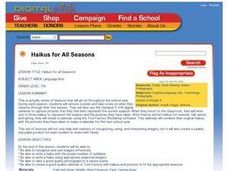Teacher's Corner
Haiku
The haiku, one of the most popular fixed forms, is the subject of this writing activity, the seventh in a series of ten poetry exercises.
National Endowment for the Humanities
The World of Haiku
Students complete a study of Japanese culture through haiku. They read and interpret haiku poetry and write haiku of their own.
Poetry4kids
How to Write a Haiku
A haiku is the focus of an activity that challenges scholars to draft an original poem. Authors discover the origin and components of a haiku, read three example poems, then follow six steps to compose their own.
Curated OER
What is a Haiku? How Do You Write a Haiku?
Haiku poetry is explored in this language arts lesson plan. Yong readers identify the characteristics of haiku and read several examples. Students make connections between their study of Japan and the poetic form of haiku, and they write...
Curated OER
Haiku Lessons With Feeling
Haiku, a form of Japanese poetry, can provide a way for students to tap into their creative abilities.
Curated OER
Writer's Notebook and Haiku
Students, after viewing various examples from students around the world, as well as writing in their Writer's Notebook, create, compose and revise a Haiku poem that sketches a "snapshot" or image in time. They incorporate the theme or...
Curated OER
Haikus for All Seasons
Young scholars venture outside and take notes on what they observe through their five senses. They use the Olympus D-545 digital cameras to capture pictures that they feel best represent the current season. Students write one to the...
Curated OER
Poetry to the Core
Second graders examine several examples of poetry in the six lessons of this unit. The lessons focus on five poetic forms, couplets, quatrains, limericks, Haiku, and free verse.
Curated OER
Social Studies: Exploring Japan
Fourth graders examine the culture and environment of Japan, beginning with a KWL chart. They use clay and cups of water to construct representations of the Japanese Islands. After designing flags representing farming and food, 4th...
Poetry4kids
How to Start a Poetry Journal
Practice makes proficient! Using a journal of their choice, authors organize pages, then begin their writing journey of on-going writing practice in which they compose all poetic forms including diamante, limerick, free verse, and more!
Curated OER
Land of the Rising Sun
Students survey aspects of traditional and modern Japanese customs and beliefs in the seven lessons of this unit. Both the culture and the geography of the country are studied in this unit.
Curated OER
Narrow Road to the Interior
Students investigate the life and work of the Japanese poet, Matsuo Basho as the Japanese poetic forms are studied. Nature, symbolism, and history are probed as the instructional activity is developed.
Curated OER
"Mother Earth" -- Present
Students examine the Native American belief of "Mother Earth". They read stories from Native American authors and reflect. They illustrate this concept through art and haikus.
Curated OER
Everyone Can Write Poetry
Embark on a journey of writing several different types of poetry. Fifth graders read several examples, and use the examples to model their own writing. Each poem is to be accompanied by a different art visual representation. In the end,...
Curated OER
Formal versus Informal Language
Engage in an activity that focuses on the concepts of formal and informal language use. Middle and high schoolers compare and contrast each style by using a Venn diagram that includes some examples. They read and hear a passage of lyrics...
















